In A Normal Cellular Protein, Where Would You Expect To Find A Hydrophobic Amino Acid Like Valine?
Biological Macromolecules
12 Proteins
Learning Objectives
Past the finish of this section, you will be able to do the post-obit:
- Describe the functions proteins perform in the cell and in tissues
- Discuss the relationship betwixt amino acids and proteins
- Explicate the four levels of protein arrangement
- Describe the ways in which protein shape and function are linked
Proteins are one of the most abundant organic molecules in living systems and have the most various range of functions of all macromolecules. Proteins may be structural, regulatory, contractile, or protective. They may serve in transport, storage, or membranes; or they may exist toxins or enzymes. Each jail cell in a living system may contain thousands of proteins, each with a unique office. Their structures, like their functions, vary greatly. They are all, yet, amino acid polymers arranged in a linear sequence.
Types and Functions of Proteins
Enzymes, which living cells produce, are catalysts in biochemical reactions (like digestion) and are usually complex or conjugated proteins. Each enzyme is specific for the substrate (a reactant that binds to an enzyme) upon which it acts. The enzyme may help in breakdown, rearrangement, or synthesis reactions. Nosotros call enzymes that break down their substrates catabolic enzymes. Those that build more complex molecules from their substrates are anabolic enzymes, and enzymes that affect the rate of reaction are catalytic enzymes. Note that all enzymes increment the reaction rate and, therefore, are organic catalysts. An example of an enzyme is salivary amylase, which hydrolyzes its substrate amylose, a component of starch.
Hormones are chemic-signaling molecules, unremarkably small proteins or steroids, secreted by endocrine cells that human activity to control or regulate specific physiological processes, including growth, development, metabolism, and reproduction. For instance, insulin is a poly peptide hormone that helps regulate the blood glucose level. (Figure) lists the principal types and functions of proteins.
| Protein Types and Functions | ||
|---|---|---|
| Blazon | Examples | Functions |
| Digestive Enzymes | Amylase, lipase, pepsin, trypsin | Help in food by catabolizing nutrients into monomeric units |
| Transport | Hemoglobin, albumin | Bear substances in the blood or lymph throughout the body |
| Structural | Actin, tubulin, keratin | Construct different structures, similar the cytoskeleton |
| Hormones | Insulin, thyroxine | Coordinate unlike torso systems' activity |
| Defense | Immunoglobulins | Protect the body from foreign pathogens |
| Contractile | Actin, myosin | Effect muscle wrinkle |
| Storage | Legume storage proteins, egg white (albumin) | Provide nourishment in early embryo evolution and the seedling |
Proteins accept different shapes and molecular weights. Some proteins are globular in shape; whereas, others are gristly in nature. For example, hemoglobin is a globular protein, only collagen, located in our pare, is a fibrous protein. Protein shape is critical to its part, and many different types of chemical bonds maintain this shape. Changes in temperature, pH, and exposure to chemicals may atomic number 82 to permanent changes in the protein's shape, leading to loss of role, or denaturation. Unlike arrangements of the aforementioned 20 types of amino acids contain all proteins. Two rare new amino acids were discovered recently (selenocystein and pirrolysine), and boosted new discoveries may be added to the list.
Amino Acids
Amino acids are the monomers that contain proteins. Each amino acid has the aforementioned fundamental construction, which consists of a cardinal carbon atom, or the alpha (α) carbon, bonded to an amino group (NH2), a carboxyl group (COOH), and to a hydrogen atom. Every amino acid also has some other atom or grouping of atoms bonded to the fundamental atom known as the R group ((Effigy)).
Amino acids have a central disproportionate carbon to which an amino grouping, a carboxyl group, a hydrogen atom, and a side chain (R group) are attached.

Scientists use the name "amino acrid" considering these acids contain both amino grouping and carboxyl-acrid-group in their basic structure. As we mentioned, there are xx common amino acids nowadays in proteins. Nine of these are essential amino acids in humans because the man body cannot produce them and we obtain them from our nutrition. For each amino acid, the R grouping (or side chain) is unlike ((Figure)).
Visual Connection
In that location are 20 mutual amino acids commonly found in proteins, each with a different R grouping (variant group) that determines its chemical nature.

Which categories of amino acid would you lot look to notice on a soluble protein's surface and which would you look to find in the interior? What distribution of amino acids would you look to detect in a protein embedded in a lipid bilayer?
The chemical nature of the side chain determines the amino acid's nature (that is, whether it is acidic, basic, polar, or nonpolar). For example, the amino acrid glycine has a hydrogen atom every bit the R group. Amino acids such as valine, methionine, and alanine are nonpolar or hydrophobic in nature, while amino acids such equally serine, threonine, and cysteine are polar and accept hydrophilic side chains. The side chains of lysine and arginine are positively charged, and therefore these amino acids are also basic amino acids. Proline has an R group that is linked to the amino group, forming a ring-similar structure. Proline is an exception to the amino acid's standard structure since its amino group is non split from the side chain ((Effigy)).
A single upper example letter or a three-letter abridgement represents amino acids. For instance, the letter of the alphabet V or the three-letter of the alphabet symbol val represent valine. Merely as some fatty acids are essential to a diet, some amino acids also are necessary. These essential amino acids in humans include isoleucine, leucine, and cysteine. Essential amino acids refer to those necessary to build proteins in the body, simply not those that the torso produces. Which amino acids are essential varies from organism to organism.
The sequence and the number of amino acids ultimately decide the protein's shape, size, and role. A covalent bond, or peptide bond, attaches to each amino acid, which a dehydration reaction forms. One amino acid'south carboxyl group and the incoming amino acid's amino grouping combine, releasing a water molecule. The resulting bond is the peptide bond ((Figure)).
Peptide bond formation is a aridity synthesis reaction. The carboxyl group of one amino acid is linked to the incoming amino acrid's amino group. In the procedure, information technology releases a water molecule.
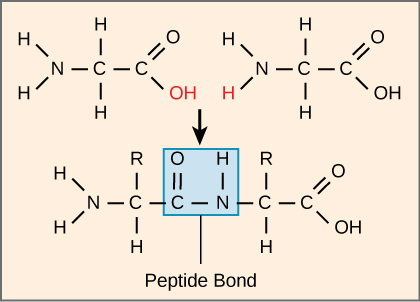
The products that such linkages class are peptides. Equally more amino acids join to this growing chain, the resulting chain is a polypeptide. Each polypeptide has a free amino group at one end. This end the N terminal, or the amino terminal, and the other end has a gratis carboxyl group, also the C or carboxyl terminal. While the terms polypeptide and protein are sometimes used interchangeably, a polypeptide is technically a polymer of amino acids, whereas the term protein is used for a polypeptide or polypeptides that have combined together, ofttimes have jump not-peptide prosthetic groups, have a singled-out shape, and have a unique role. After protein synthesis (translation), most proteins are modified. These are known as postal service-translational modifications. They may undergo cleavage, phosphorylation, or may require adding other chemic groups. Just subsequently these modifications is the protein completely functional.
Development Connection
The Evolutionary Significance of Cytochrome cCytochrome c is an of import component of the electron transport chain, a part of cellular respiration, and it is normally located in the cellular organelle, the mitochondrion. This poly peptide has a heme prosthetic grouping, and the heme's central ion alternately reduces and oxidizes during electron transfer. Because this essential protein's role in producing cellular energy is crucial, it has changed very little over millions of years. Protein sequencing has shown that at that place is a considerable amount of cytochrome c amino acid sequence homology among different species. In other words, we can assess evolutionary kinship by measuring the similarities or differences among various species' DNA or protein sequences.
Scientists accept determined that homo cytochrome c contains 104 amino acids. For each cytochrome c molecule from different organisms that scientists have sequenced to appointment, 37 of these amino acids appear in the same position in all cytochrome c samples. This indicates that there may have been a common antecedent. On comparing the human and chimpanzee poly peptide sequences, scientists did not find a sequence difference. When researchers compared human being and rhesus monkey sequences, the single difference was in one amino acid. In another comparison, homo to yeast sequencing shows a difference in the 44th position.
Protein Construction
As we discussed before, a poly peptide's shape is critical to its function. For example, an enzyme can bind to a specific substrate at an active site. If this agile site is contradistinct because of local changes or changes in overall protein construction, the enzyme may be unable to demark to the substrate. To understand how the poly peptide gets its concluding shape or conformation, we need to sympathize the 4 levels of poly peptide structure: principal, secondary, third, and quaternary.
Chief Construction
Amino acids' unique sequence in a polypeptide chain is its chief construction. For example, the pancreatic hormone insulin has two polypeptide bondage, A and B, and they are linked together by disulfide bonds. The Northward terminal amino acid of the A chain is glycine; whereas, the C terminal amino acrid is asparagine ((Figure)). The amino acid sequences in the A and B chains are unique to insulin.
Bovine serum insulin is a protein hormone comprised of two peptide bondage, A (21 amino acids long) and B (30 amino acids long). In each chain, three-letter abbreviations that stand for the amino acids' names in the lodge they are present signal principal structure. The amino acid cysteine (cys) has a sulfhydryl (SH) grouping equally a side chain. Ii sulfhydryl groups can react in the presence of oxygen to form a disulfide (S-S) bond. 2 disulfide bonds connect the A and B chains together, and a third helps the A chain fold into the right shape. Note that all disulfide bonds are the same length, just we have drawn them different sizes for clarity.
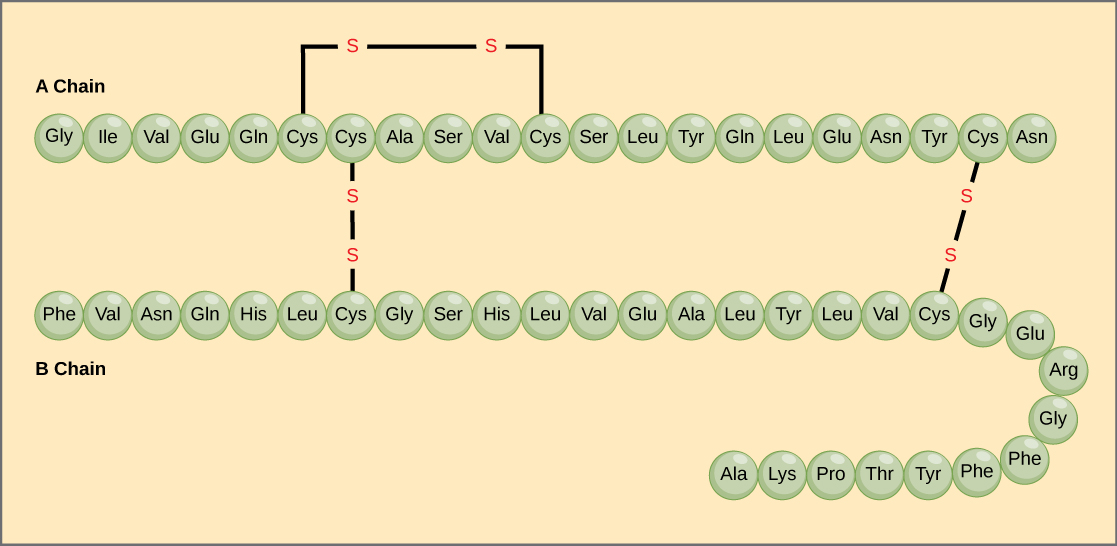
The gene encoding the protein ultimately determines the unique sequence for every protein. A change in nucleotide sequence of the gene'south coding region may atomic number 82 to adding a different amino acid to the growing polypeptide chain, causing a modify in protein structure and function. In sickle cell anemia, the hemoglobin β concatenation (a small portion of which we bear witness in (Figure)) has a single amino acid substitution, causing a change in poly peptide construction and function. Specifically, valine in the β chain substitutes the amino acid glutamic. What is about remarkable to consider is that a hemoglobin molecule is comprised of two blastoff and ii beta bondage that each consist of almost 150 amino acids. The molecule, therefore, has nearly 600 amino acids. The structural divergence between a normal hemoglobin molecule and a sickle cell molecule—which dramatically decreases life expectancy—is a single amino acrid of the 600. What is even more remarkable is that three nucleotides each encode those 600 amino acids, and a single base change (point mutation), 1 in 1800 bases causes the mutation.
The beta concatenation of hemoglobin is 147 residues in length, even so a single amino acid substitution leads to sickle prison cell anemia. In normal hemoglobin, the amino acrid at position 7 is glutamate. In sickle jail cell hemoglobin, a valine replaces glutamate.
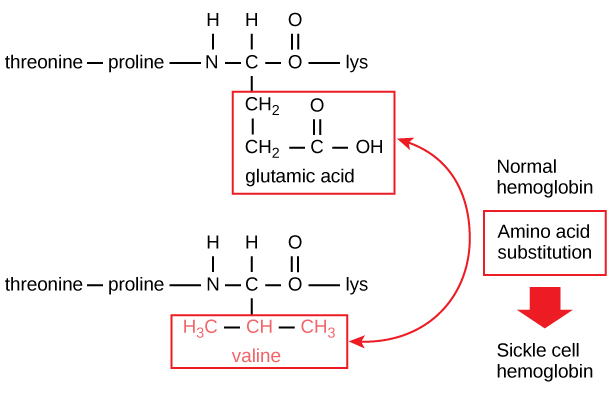
Because of this alter of ane amino acrid in the chain, hemoglobin molecules form long fibers that misconstrue the biconcave, or disc-shaped, red blood cells and causes them to presume a crescent or "sickle" shape, which clogs claret vessels ((Figure)). This tin can lead to myriad serious wellness problems such every bit breathlessness, dizziness, headaches, and intestinal hurting for those afflicted past this disease.
In this blood smear, visualized at 535x magnification using bright field microscopy, sickle cells are crescent shaped, while normal cells are disc-shaped. (credit: modification of work past Ed Uthman; scale-bar data from Matt Russell)
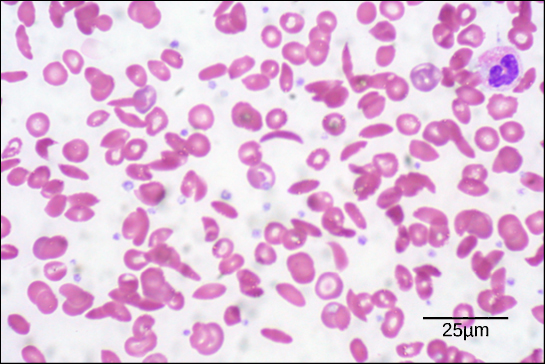
Secondary Structure
The local folding of the polypeptide in some regions gives rising to the secondary structure of the poly peptide. The most common are the α-helix and β-pleated sail structures ((Effigy)). Both structures are held in shape by hydrogen bonds. The hydrogen bonds form between the oxygen atom in the carbonyl group in 1 amino acid and some other amino acid that is four amino acids farther along the chain.
The α-helix and β-pleated sheet are secondary structures of proteins that form because of hydrogen bonding between carbonyl and amino groups in the peptide backbone. Certain amino acids have a propensity to form an α-helix, while others accept a propensity to course a β-pleated sheet.
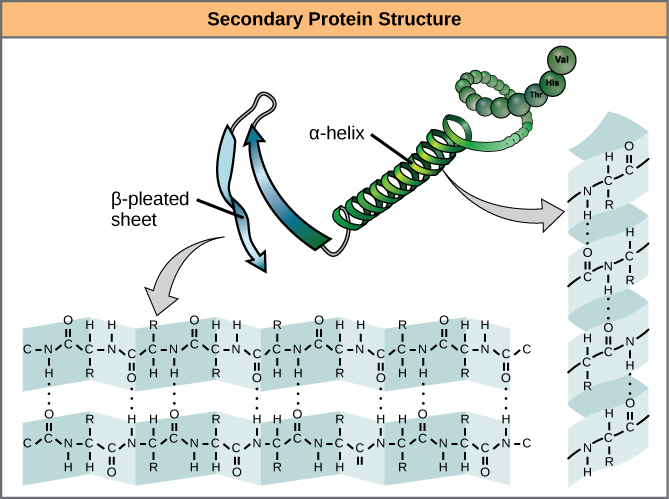
Every helical turn in an alpha helix has three.half-dozen amino acid residues. The polypeptide's R groups (the variant groups) protrude out from the α-helix concatenation. In the β-pleated sheet, hydrogen bonding betwixt atoms on the polypeptide concatenation's backbone form the "pleats". The R groups are attached to the carbons and extend above and below the pleat'southward folds. The pleated segments align parallel or antiparallel to each other, and hydrogen bonds form between the partially positive nitrogen cantlet in the amino grouping and the partially negative oxygen atom in the peptide backbone's carbonyl grouping. The α-helix and β-pleated sheet structures are in about globular and fibrous proteins and they play an important structural role.
Tertiary Structure
The polypeptide'due south unique three-dimensional structure is its 3rd structure ((Figure)). This structure is in part due to chemical interactions at work on the polypeptide concatenation. Primarily, the interactions among R groups create the protein'southward circuitous three-dimensional tertiary construction. The nature of the R groups in the amino acids involved tin can counteract forming the hydrogen bonds we described for standard secondary structures. For instance, R groups with like charges repel each other and those with unlike charges are attracted to each other (ionic bonds). When protein folding takes place, the nonpolar amino acids' hydrophobic R groups lie in the protein'due south interior; whereas, the hydrophilic R groups lie on the exterior. Scientists as well telephone call the old interaction types hydrophobic interactions. Interaction betwixt cysteine side bondage forms disulfide linkages in the presence of oxygen, the only covalent bond that forms during protein folding.
A variety of chemical interactions decide the proteins' tertiary structure. These include hydrophobic interactions, ionic bonding, hydrogen bonding, and disulfide linkages.
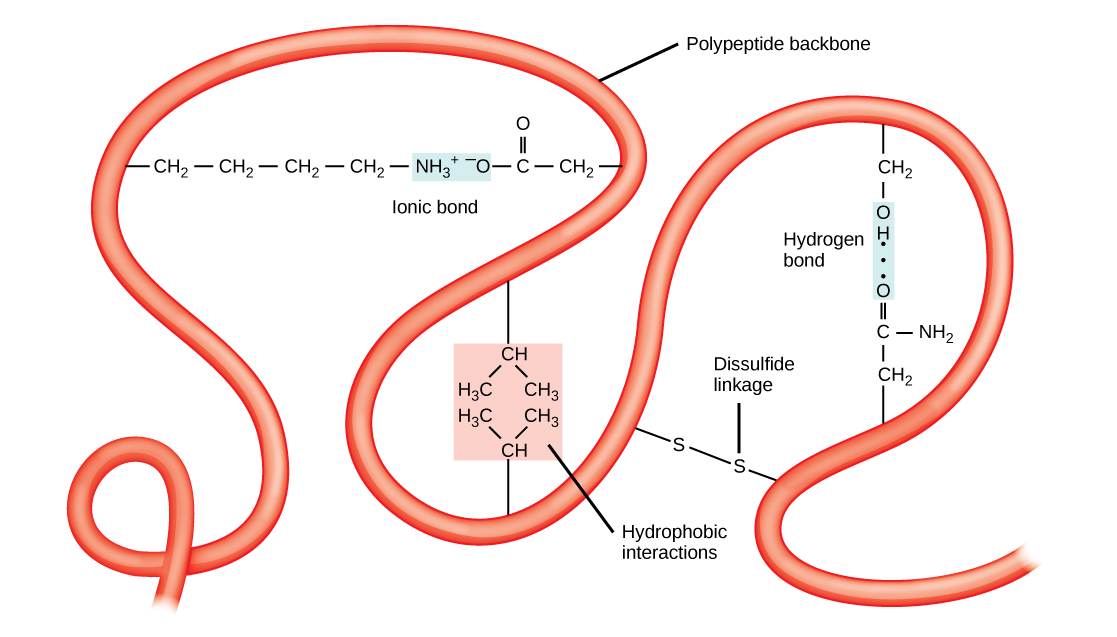
All of these interactions, weak and potent, determine the protein's final three-dimensional shape. When a poly peptide loses its 3-dimensional shape, it may no longer exist functional.
Quaternary Structure
In nature, some proteins grade from several polypeptides, or subunits, and the interaction of these subunits forms the quaternary structure. Weak interactions betwixt the subunits help to stabilize the overall structure. For case, insulin (a globular protein) has a combination of hydrogen and disulfide bonds that cause it to mostly dodder into a ball shape. Insulin starts out as a single polypeptide and loses some internal sequences in the presence of post-translational modification after forming the disulfide linkages that hold the remaining chains together. Silk (a fibrous protein), however, has a β-pleated sheet structure that is the event of hydrogen bonding between dissimilar bondage.
(Figure) illustrates the four levels of protein structure (primary, secondary, 3rd, and quaternary).
Observe the four levels of protein structure in these illustrations. (credit: modification of work by National Human Genome Enquiry Institute)
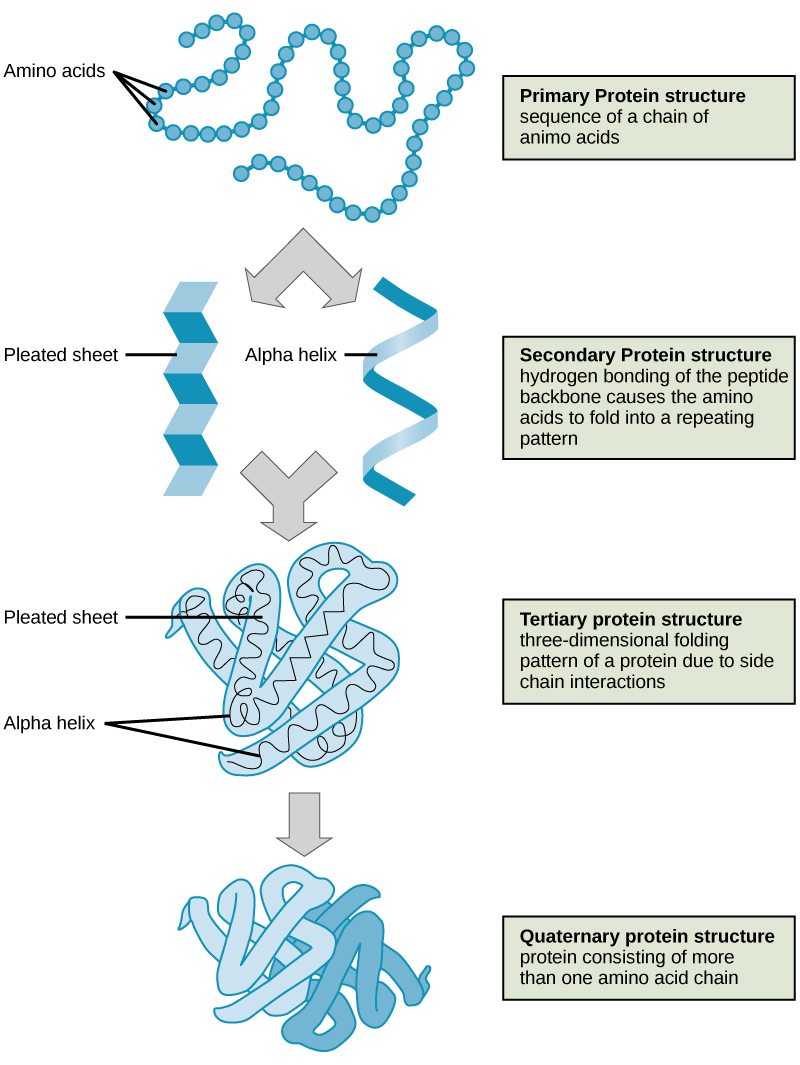
Denaturation and Protein Folding
Each protein has its ain unique sequence and shape that chemical interactions agree together. If the poly peptide is subject area to changes in temperature, pH, or exposure to chemicals, the protein structure may change, losing its shape without losing its main sequence in what scientists call denaturation. Denaturation is frequently reversible because the polypeptide's primary structure is conserved in the process if the denaturing agent is removed, allowing the protein to resume its function. Sometimes denaturation is irreversible, leading to loss of function. I example of irreversible protein denaturation is frying an egg. The albumin protein in the liquid egg white denatures when placed in a hot pan. Non all proteins denature at loftier temperatures. For instance, bacteria that survive in hot springs have proteins that function at temperatures shut to boiling. The stomach is as well very acidic, has a low pH, and denatures proteins as part of the digestion procedure; withal, the stomach's digestive enzymes retain their activity under these conditions.
Protein folding is critical to its part. Scientists originally thought that the proteins themselves were responsible for the folding procedure. Just recently researchers discovered that frequently they receive assistance in the folding process from protein helpers, or chaperones (or chaperonins) that associate with the target protein during the folding process. They human activity by preventing polypeptide aggregation that comprise the complete poly peptide structure, and they disassociate from the protein once the target protein is folded.
Link to Learning
For an boosted perspective on proteins, view this animation called "Biomolecules: The Proteins."
Section Summary
Proteins are a class of macromolecules that perform a diverse range of functions for the prison cell. They assist in metabolism by acting as enzymes, carriers, or hormones, and provide structural back up. The building blocks of proteins (monomers) are amino acids. Each amino acrid has a central carbon that bonds to an amino group, a carboxyl group, a hydrogen atom, and an R group or side chain. There are 20 commonly occurring amino acids, each of which differs in the R group. A peptide bond links each amino acid to its neighbors. A long amino acid chain is a polypeptide.
Proteins are organized at iv levels: primary, secondary, tertiary, and (optional) quaternary. The primary structure is the amino acids' unique sequence. The polypeptide's local folding to form structures such every bit the α-helix and β-pleated sheet constitutes the secondary structure. The overall three-dimensional structure is the tertiary structure. When two or more polypeptides combine to class the complete protein structure, the configuration is the protein's quaternary structure. Poly peptide shape and function are intricately linked. Any change in shape caused by changes in temperature or pH may atomic number 82 to protein denaturation and a loss in office.
Visual Connexion Questions
(Figure) Which categories of amino acid would yous expect to find on the surface of a soluble protein, and which would you wait to find in the interior? What distribution of amino acids would you expect to find in a protein embedded in a lipid bilayer?
(Effigy) Polar and charged amino acid residues (the residual after peptide bond formation) are more than probable to exist found on the surface of soluble proteins where they can interact with water, and nonpolar (due east.yard., amino acid side chains) are more than likely to exist found in the interior where they are sequestered from h2o. In membrane proteins, nonpolar and hydrophobic amino acid side chains associate with the hydrophobic tails of phospholipids, while polar and charged amino acid side chains interact with the polar caput groups or with the aqueous solution. Even so, there are exceptions. Sometimes, positively and negatively charged amino acid side chains interact with 1 some other in the interior of a protein, and polar or charged amino acrid side chains that collaborate with a ligand tin be found in the ligand binding pocket.
Review Questions
The monomers that make up proteins are called ________.
- nucleotides
- disaccharides
- amino acids
- chaperones
C
The α-helix and the β-pleated sheet are role of which protein construction?
- primary
- secondary
- tertiary
- quaternary
B
Mad cow disease is an communicable diseases where ane misfolded poly peptide causes all other copies of the poly peptide to brainstorm misfolding. This is an example of a disease impacting ____ structure.
- primary
- secondary
- tertiary
- fourth
C
Critical Thinking Questions
Explain what happens if fifty-fifty one amino acid is substituted for another in a polypeptide chain. Provide a specific example.
A change in gene sequence can lead to a different amino acid being added to a polypeptide concatenation instead of the normal one. This causes a modify in protein structure and function. For example, in sickle cell anemia, the hemoglobin β concatenation has a single amino acid substitution—the amino acid glutamic acid in position six is substituted past valine. Because of this modify, hemoglobin molecules form aggregates, and the disc-shaped cherry claret cells assume a crescent shape, which results in serious wellness problems.
Describe the differences in the 4 poly peptide structures.
The sequence and number of amino acids in a polypeptide concatenation is its primary structure. The local folding of the polypeptide in some regions is the secondary construction of the protein. The 3-dimensional structure of a polypeptide is known as its tertiary structure, created in part past chemical interactions such equally hydrogen bonds betwixt polar side chains, van der Waals interactions, disulfide linkages, and hydrophobic interactions. Some proteins are formed from multiple polypeptides, also known as subunits, and the interaction of these subunits forms the 4th construction.
Aquaporins are proteins embedded in the plasma membrane that allow water molecules to motility between the extracellular matrix and the intracellular space. Based on its office and location, describe the key features of the poly peptide'south shape and the chemical characteristics of its amino acids.
The poly peptide must form a aqueduct in the plasma membrane that allows h2o into the cell since water cannot cross the plasma membrane by itself. Since aquaporins are embedded in the plasma membrane and connect with both the intracellular and extracellular spaces, it must be amphipathic like the plasma membrane. The pinnacle and bottom of the protein must contain charged or polar amino acids (hydrophilic) to interact with the aqueous environments. The exterior transmembrane region must incorporate non-polar amino acids (hydrophobic) that can collaborate with the phospholipid tails. Nevertheless, the inside of this aqueduct must contain hydrophilic amino acids since they will interact with the traveling water molecules.
Glossary
- alpha-helix construction (α-helix)
- type of secondary protein structure formed by folding the polypeptide into a helix shape with hydrogen bonds stabilizing the construction
- amino acid
- a protein's monomer; has a central carbon or alpha carbon to which an amino grouping, a carboxyl grouping, a hydrogen, and an R group or side concatenation is attached; the R group is different for all twenty common amino acids
- beta-pleated sheet (β-pleated)
- secondary structure in proteins in which hydrogen bonding forms "pleats" between atoms on the polypeptide concatenation'south backbone
- chaperone
- (also, chaperonin) protein that helps nascent poly peptide in the folding procedure
- denaturation
- loss of shape in a poly peptide as a result of changes in temperature, pH, or chemical exposure
- enzyme
- catalyst in a biochemical reaction that is unremarkably a circuitous or conjugated protein
- hormone
- chemical signaling molecule, usually protein or steroid, secreted by endocrine cells that act to control or regulate specific physiological processes
- peptide bond
- bail formed between 2 amino acids by a dehydration reaction
- polypeptide
- long chain of amino acids that peptide bonds link
- primary structure
- linear sequence of amino acids in a protein
- poly peptide
- biological macromolecule comprised of one or more amino acrid chains
- quaternary structure
- association of discrete polypeptide subunits in a protein
- secondary structure
- regular structure that proteins form by intramolecular hydrogen bonding betwixt the oxygen cantlet of one amino acid residuum and the hydrogen attached to the nitrogen atom of another amino acid residuum
- 3rd structure
- a protein'south iii-dimensional conformation, including interactions between secondary structural elements; formed from interactions between amino acid side chains
Source: https://opentextbc.ca/biology2eopenstax/chapter/proteins/
Posted by: careydrife1958.blogspot.com

0 Response to "In A Normal Cellular Protein, Where Would You Expect To Find A Hydrophobic Amino Acid Like Valine?"
Post a Comment